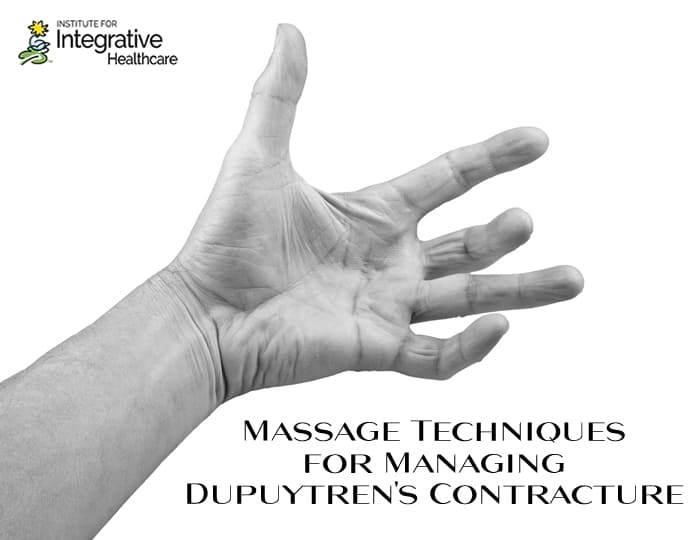

While it is not an affliction that will ultimately result in death, Dupuytren’s Disease can cause a significant reduction in quality of life.
For those who are unfamiliar with the condition, Dupuytren’s Disease, also known as Dupuytren’s contracture, causes a thickening of the fascial tissue surrounding the muscles of the hand (1). The fingers and muscles on the medial side of the hand (the pinky and ring finger) are most frequently affected. However, in some cases, the thumb and other fingers may also be involved. As the disease progresses, the fingers start to close more and more until, in extreme cases, the fingers are squeezed so tightly that the skin underneath the closed fingers can become macerated (2).
Some fast facts about Dupuytren’s Contracture include:
- Roughly 5% of Americans over the age of 35 suffer from the condition (3).
- There is no cure (1, 3).
- No known cause has been identified, but genetics seems to be a crucial risk factor (4).
- Contrary to what one would think by observing, the tendons of the hand are not directly involved (5).
- Surgery and splinting are two of the most common treatment recommendations (4, 6).
But even though many patients will require surgery to address Dupuytren’s contracture, there is a pressing need for effective non-operative treatments (4, 7), and massage combined with gentle stretching shows promise as an intervention (7, 8).
Massage Therapy for Dupuytren’s Contracture
As was stated in the introduction, Dupuytren’s affects the fascia surrounding tissues. Therefore, a brief review of fascial anatomy and physiology will help to put the discussed treatments, detailed later in this article, into context.
Fascia A&P
If you’ve never had the experience of working with a cadaver before, take the word of those that have: there is a layer of fascia covering nearly every structure in the body.
This ubiquitous fascia creates an interconnected web that links organs, muscles, tendons and many of our other tissues. Additionally, it may even provide a means of force transmission (9).
Because of this, many massage therapists will incorporate “fascial massages” into their practice in order to address musculoskeletal issues and even organ-related conditions. The belief is that these fascial massage techniques will relieve tension in the fascia which, in turn, will relieve pain or tension in the associated area. This is a specific treatment philosophy that is examined to a greater depth in this paper (10).
Hand-Specific Fascial Considerations
There is a thick layer of fascia that encapsulates the various muscles and tendons of the palm of the hand known as the palmar fascia (11). This tissue is intimately connected with the fascia, nerves, and arteries that are associated with all of the other areas around the hand, forearm and upper arm (11, 12).
With Dupuytren’s Contracture, the appearance of a thick band running parallel with the hand would seem to indicate that tendons are involved in the process and are causing the contractures specific to the condition. However, the only tissue directly involved with Dupuytren’s is the palmar fascia overlying the muscles and tendons (5).
Contracture Massage: How Hard Should You Push?
For the novice massage therapist, or even just the casual observer, it may seem like kneading and applying a significant amount of pressure to a Dupuytren’s contracture would help to release the tension. When it comes to Dupuytren’s Contracture, relatively gentle pressure is the best way to proceed (13).
Circular Massage and Gentle ROM
Light, circular pressure throughout the areas of the contracture combined with mild stretching or passive ROM are the primary massage treatment guidelines for Dupuytren’s Contracture (7, 8, 14).
As you’ll see in the detailed video below, taking your time and paying attention to the small details of the hand will go a long way in the treatment of the condition (14).
CFM Shows Promise
Additional research has found that performing specific cross-friction massage (CFM) combined with stretching in the area of the contracture can help with the condition. While more research is needed, this further shows the efficacy of non-surgical treatments for Dupuytren’s (8).
Massage Before and After Surgery is Recommended
In some cases, the condition will have progressed to a point where surgery is the only viable corrective option. In these situations, a course of massage before and after the operation may improve outcomes and patient satisfaction (13).
Other Considerations for the Management of Dupuytren’s Contracture
When a client with Dupuytren’s comes to a massage therapist for help, the clinician has a unique role in the management of the condition. The patient-therapist relationship will involve working in a one-on-one capacity during the sessions. Because of this, patients will often feel comfortable opening up to the therapist about concerns or issues they may be having (15).
While it is unfortunate, it’s likely the case that the patient has not really been provided with much education related to their condition prior to seeing a massage therapist (16). Many medical professionals may see Dupuytren’s Contracture as a condition that is not life threatening and thus, not worthy of the extra effort involved in outlining the patient’s treatment options.
This provides you with the opportunity to educate the patient and help him or her manage the condition from a biopsychosocial perspective (17).
Educate the Patient
Depending on the patient, it’s possible that they simply do not understand their condition. Therefore, the massage therapist has the ability to empower the patient and teach them about Dupuytren’s Contracture. The more knowledge one has about their condition, the less fear and frustration they tend to experience which, in turn,. leads to a higher degree of patient satisfaction (17).
Assist with Managing the Biopsychosocial Components
The biological or physical manifestations of the disease process are obvious through visual and tactile examination. But the trickier components of conditions such as Dupuytren’s stem from the psychological and social aspects of a patient’s life.
- What have they had to give up as a result of their condition?
- Are they feeling depressed that they have had to adapt to a new way of life?
The person may confide these things in his or her massage therapist throughout the course of treatment. Helping patients achieve a better mental state and understanding of their continued value to their families and society is something that a massage therapist can also assist with.
A good starting place for patients and massage therapists alike, is the Dupuytren’s Foundation (3). This organization provides a wealth of resources and can help patients on their road to recovery.
Conclusion
Dupuytren’s Contracture is a difficult condition for both patients and clinicians to manage. While many times patients are encouraged to pursue surgical solutions to the issue, massage therapy is a viable treatment option to address the biopsychosocial manifestations of the condition.













